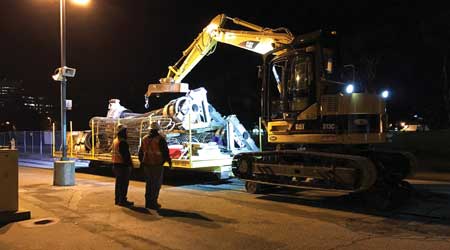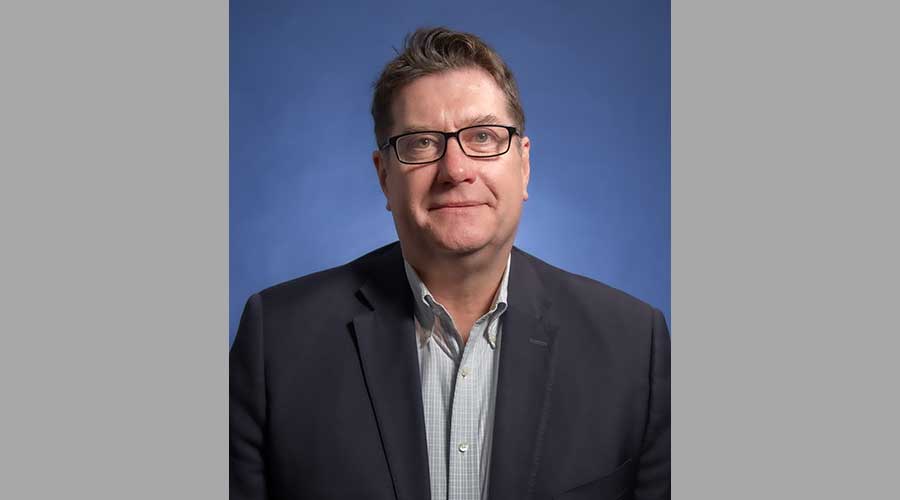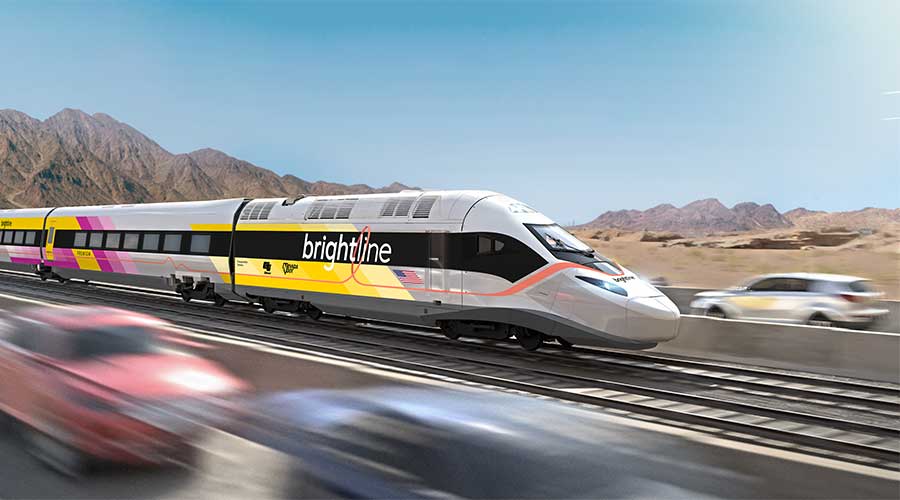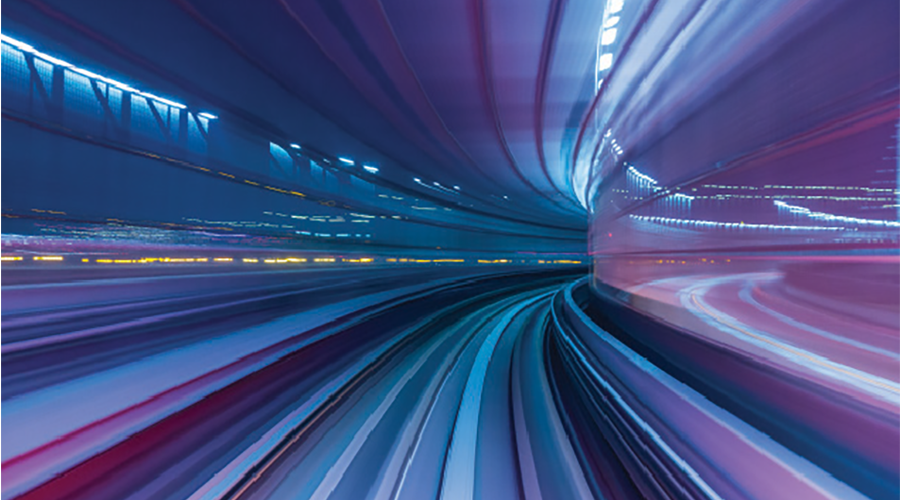Stay updated on news, articles and information for the rail industry
 railPrime
railPrime
March 2018
Rail News: Passenger Rail
Caltrain's electrification project is finally under construction

By Julie Sneider, Senior Associate Editor
The project to modernize the Caltrain commuter-rail system between San Francisco and San Jose took a giant step forward in July 2017, when California Gov. Jerry Brown and other state, federal and transportation officials broke ground on a decades-old effort to electrify the railroad's corridor.
Caltrain officials have declared the $1.98 billion project the most important improvement in the railroad's history, which dates back to 1863 when passenger-rail service began on the peninsula corridor under the authority of San Francisco and San Jose Railroad Co.

The plan to construct an overhead catenary system and switch to electric multiple unit (EMU) trains is the key component of the Caltrain Modernization Program, which the railroad now promotes under the acronym CalMod.
Today, Caltrain transports about 65,000 Bay Area commuters daily. Over the past decade, the railroad’s ridership has increased substantially and the agency expects it to continue growing as the Bay Area’s population increases. The passenger-rail service — which currently is operating at capacity — is considered a viable alternative to the heavily congested U.S. 101 and Interstate 280 highways that connect downtown San Francisco to San Jose and the Silicon Valley.
With passenger service on the electrified system expected to begin in 2022, the modernization effort soon will upgrade the railroad’s performance and operating efficiency, as well as increase capacity, safety and reliability, Caltrain officials believe.
"First the railroad was steam, then it was diesel for a long time and now it's being electrified," says Casey Fromson, Caltrain's director of government and community affairs. "For us, this is a foundation for a whole transformation of the railroad."
The idea for having an electrified Caltrain system surfaced as a key strategy in the 1990s, as the region sought ways to improve commuter-rail service in the growing San Francisco area. The railroad’s strategic plan made electrification a priority in 1999. It took another 16 years before Caltrain received environmental clearance for its electrification goals.
Faster, cleaner rail service
The project will cover 52 track miles through 17 cities and two counties, starting from the 4th and King Station in San Francisco and concluding at the Tamien Station in San Jose. Its intended purpose: to produce faster and more frequent rail service, as well as improve the environment by reducing air pollution, greenhouse-gas emissions, noise and vibration.
Project components include the installation of two substations for traction power, poles and an overhead catenary system; upgrades to signals and grade crossings; and the acquisition of EMUs to replace the majority of the railroad's diesel trains.
Train performance is expected to improve in part because electrified trains can accelerate and decelerate faster than diesel-powered trains, which improves efficiency. EMU engines also produce less noise than diesel engines and are designed to emit substantially less air pollution than diesel trains operating in the corridor. If ridership increases as expected, automobile usage will decline, further contributing to fewer greenhouse-gas emissions, Caltrain officials believe.
The first major contracts for the project were issued in August 2016. Caltrain signed a $697 million design-build electrification contract with Balfour Beatty Infrastructure Inc. — the largest the company has secured in the United States, according to the contracting firm.
Balfour Beatty will design and build a 25kv AC overhead catenary system (OCS) that will power the new trains, as well as construct two traction power substations, one switching substation and seven paralleling substations. Additionally, the contract calls for the company to replace signal systems, according to a Balfour Beatty press release.
Also in August 2016, Caltrain awarded the project's second major contract to Stadler U.S. Inc., which will manufacture and deliver 16, six-car double-decker EMU trains. Valued at $551 million, the contract includes an option to purchase additional cars for a total of 96 units.
The contract marked the first time that Stadler sold its lightweight double-decker trains in the United States. Replacing the railroad's existing heavy steel-construction diesel fleet with the "state of the art," lightweight aluminum trains will help significantly decrease Caltrain's greenhouse-gas and noise emissions, according to Stadler's website.
A new plant in Salt Lake City
Because the Caltrain electrification project is partially funded by federal dollars, the U.S. Buy America Act provisions require that the final assembly and testing of the trains occur in the United States.
To accommodate those provisions, Stadler broke ground in October 2017 on a $50 million train assembly plant in Salt Lake City. The company will design the trains and manufacture their shells and components in Switzerland, where its parent company is based, before shipping them for assembly in Utah.
Potentially, Stadler may pursue other contracts that can be accommodated at the Salt Lake City plant, says Liria Larano, deputy chief of the CalMod project.
Just before construction was set to begin last year, the project nearly came to a halt when California's Republican delegation in Congress moved to block a $650 million federal Full Funding Grant Agreement (FFGA) slated for Caltrain's electrification effort because of the lawmakers' opposition to the state's much larger high-speed rail (HSR) project between San Francisco and Los Angeles.
The two initiatives are separate projects, yet Republican opponents to the state's HSR program argued that they were intertwined because the high-speed service would need electrified rails. U.S. Rep. Jeff Denham (R-Calif.) — a strong opponent of the state’s high-speed initiative — noted that the Caltrain project also was relying on some state HSR funds.
The Federal Transit Administration (FTA) under President Obama’s administration recommended Caltrain’s FFGA be approved. However, after President Donald Trump was inaugurated in January 2017, the California Republican delegation called on the administration not to sign off on the Caltrain FFGA. U.S. Transportation Secretary Elaine Chao — the Trump administration’s appointee — declined to approve it because she didn’t have the federal funding to OK the grant. Her decision put the Caltrain project in jeopardy of losing already approved contracts.
A business case for CalMod
Caltrain General Manager and Chief Executive Officer Jim Hartnett, along with local community and business leaders who support an electrified railroad, insisted that the project was necessary to modernize the region’s commuter-rail system. Dropping the project 15 years in the making with signed contracts in place would cost the Bay Area economy many jobs and a lot of money, they said in calling for the FFGA’s approval.
Hartnett even traveled to Washington, D.C., to lobby for the grant. Then, on May 22, 2017, the FTA reversed course.
The agency determined it would sign off on the FFGA after agreeing to release $100 million in federal money appropriated by Congress. FTA officials committed the rest of the federal dollars in future congressional appropriations.
The remaining funding for the project will come from state and local coffers. But the debate over the FFGA caused Caltrain to delay its groundbreaking by about four months.
"Since the groundbreaking in July, we've advanced the design for the overhead catenary system, the signal system and traction power system," says Larano. "We've also started to do construction work, now that we have full funding."
Now that it's underway, the construction has been divided into geographic segments to minimize operational impacts on the railroad. Foundational work is in progress for the poles that will be raised to support the OCS system. The foundation for each pole is 20 to 30 feet deep and spaced about 200 feet apart on the right of way. The poles and foundations were designed to resist seismic and other live loads, according to Larano.
As of late January 2018, crews had completed about 200 out of about 3,000 foundations that need to be installed, she says.
"In addition to the foundation work, we are also preparing to install the traction power facilities and acquiring the property that we need for those," says Larano.
Those 10 facilities — which will provide and regulate the power to the overall system — will include two main substations (one in San Francisco, the other in San Jose), a switching station in the middle of the right of way and seven smaller stations that are spaced 5 miles apart in the right of way. Construction of the substations — expected to begin later this year — will take six to 10 months to complete.
Currently, the substation portion of the project is in the design phase, Larano says.
Once the foundations are complete, crews will return at a later time with cranes and off-track equipment to install the 30-to-50-foot poles that will support the wires. Using on-track equipment, workers will string the four wires needed to power the train.
After installation of poles and wires is completed, traction power will be added to the system. To test the electric power without damaging the new trains, Caltrain will purchase from Amtrak an old electric locomotive that will be used mainly for testing. A separate, 1-mile segment off the mainline is being constructed for that purpose.
"Testing will be a big part of the work after we install the poles and wire," Larano says.
Construction of the electrification infrastructure is scheduled to continue until late 2020.
Meanwhile, construction of the train shells has begun in Switzerland, with the first shell scheduled to arrive in Salt Lake City later this year. The first completed EMU is scheduled to arrive in California in 2019, with the last set scheduled to arrive in the state in 2021.
Also advancing is design of the signal system for Caltrain's crossings.
"We have 42 grade crossings and we need to modify the signal system to be compatible with the electrified system,” says Larano.
Pacific Gas and Electric Co. (PG&E), which will supply the power to support the new electrified trains, has begun relocating its electric facilities along the 52-mile corridor to support Caltrain's new system. Later this year, PG&E will provide temporary power for testing the trains, while permanent power is expected to be provided in 2021. After that comes the integrated and pre-revenue testing phase of the power system and new trains.
"One of the challenges in both design and construction is to make sure we minimize the impact of the work we're doing on the existing operation," says Larano. "There is maintenance work on the existing service that has to happen on a regular basis. There are other non-electrification capital projects that are also happening on the right of way."
For example, Caltrain has a grade separation project underway in San Mateo about a mile within a segment that is being electrified. The concern was how to enable two separate contractors to complete their work without getting in each other's way, says Larano.
The solution? Let the grade-separation contractor perform foundation work for both projects. Once the grade-separation contractor finishes those foundations, the electrification contractor will come in and install the poles and wires, she says.
Another challenge: minimize rider inconvenience during construction. As a result, foundation work on the right of way is limited to times outside of peak travel periods, which run from 6 to 9 a.m and from 4 to 7 p.m. Caltrain also modified its schedule to allow longer work windows on weekends.
More contracts to come
Still to be awarded are two major contracts: tunnel notching to improve train clearance in four tunnels in San Francisco and site modifications to a Caltrain maintenance facility in San Jose, where the electric trains will be maintained. So far, other contracts also have been awarded to Gannett Fleming, ARINC Inc., LTK Engineering Services and AECOM for portions of the project.
In addition to helping the environment and improving commuter-rail service, CalMod is creating jobs — and not just in California and Utah, says Caltrain's Fromson. A Caltrain study estimated the modernization program will ultimately lead to about 10,000 direct and indirect job opportunities in Florida, Georgia, Indiana, Maryland, New Jersey, North Carolina, Pennsylvania, South Carolina, Texas, Virginia, West Virginia and Wisconsin.
Future job creation will depend on Caltrain's ability to attract funding for improvements that go beyond the current electrification program, which will result in a 75 percent replacement of its diesel fleet. CalMod goes further, calling for electrifying the railroad’s entire fleet. "This electrification project will not be the end of Caltrain’s evolution," says Fromson. "It's really the foundation for making dramatic changes to upgrade and modernize the entire corridor."
Caltrain officials are searching for funding for some of those future improvements, she says. "But the electrification is the base that allows us to think about future enhancements."
Email comments or questions to julie.sneider@tradepress.com
Keywords
Browse articles on Caltrain electrification project Caltrain Modernization Program CalMod Liria Larano Casey Fromson Balfour Beatty Infrastructure Inc. Gov. Jerry Brown San Francisco Bay area commuters San Jose Calif. catenary system electric multiple unit EMU Stadler U.S. Inc. Gannett Fleming LTKContact Progressive Railroading editorial staff.


 LRW Honors Amtrak’s Acheson As Railway Woman Of The Year
LRW Honors Amtrak’s Acheson As Railway Woman Of The Year
 From Editor-In-Chief Foran: Of Gender Equity And Inclusion
From Editor-In-Chief Foran: Of Gender Equity And Inclusion
 Spotlight On Some Of Today’s Rail Safety Products
Spotlight On Some Of Today’s Rail Safety Products
 Women of Influence in Rail eBook
Women of Influence in Rail eBook








